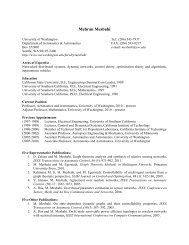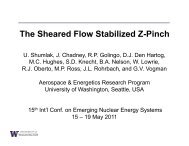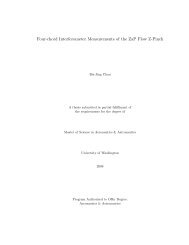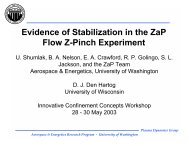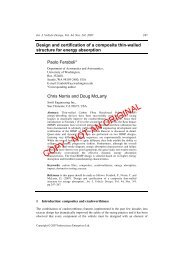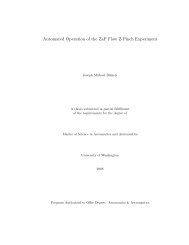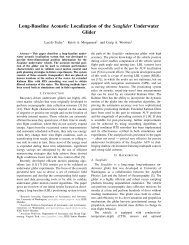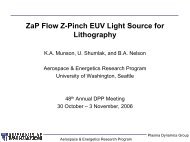Distributed Reactive Collision Avoidance - University of Washington
Distributed Reactive Collision Avoidance - University of Washington
Distributed Reactive Collision Avoidance - University of Washington
You also want an ePaper? Increase the reach of your titles
YUMPU automatically turns print PDFs into web optimized ePapers that Google loves.
38<br />
which are described graphically in Fig. 4.7.<br />
Define ɛ t , ɛ n , ɛ b > 0 as thresholds such that when |p t | > ɛ t , the conflict is far enough<br />
away that it can be ignored (and likewise for p n and p b ). The n-vehicle deconfliction maintenance<br />
controller running on vehicle i computes p t , p n , and p b to each <strong>of</strong> the other vehicles<br />
and then finds the closest conflict in each direction, i.e.<br />
p + t i<br />
p − t i<br />
= min<br />
j∈D {p t,ij > 0, ɛ ti }<br />
= − max<br />
j∈D {p t,ij < 0, −ɛ ti } ,<br />
(4.20)<br />
and likewise for p n and p b . Note that by definition 0 < p ± ≤ ɛ. To simplify notation, in any<br />
case where a relation holds in the tangent, normal, and binormal directions, the subscript<br />
will be suppressed.<br />
The input is constructed using a function, F , such that in each direction u = F (p + , p − ).<br />
The control function chosen for this implementation <strong>of</strong> the DRCA algorithm is<br />
F (p + , p − ) = u min<br />
ɛ<br />
p + + u max<br />
p − + u d − u max − u min<br />
p + p − , (4.21)<br />
ɛ<br />
ɛ 2<br />
because it is a bilinear interpolation <strong>of</strong> the following ordered triples <strong>of</strong> the form (p + , p − , u):<br />
P 1 = (0, 0, 0) P 2 = (ɛ, 0, u min )<br />
P 3 = (0, ɛ, u max ) P 4 = (ɛ, ɛ, u d ).<br />
(4.22)<br />
An example <strong>of</strong> this control function is shown in Fig. 4.8. Because F depends on the desired<br />
control, u d must be saturated such that<br />
u min ≤ u d ≤ u max . (4.23)<br />
This choice <strong>of</strong> control function means that once the u vector is constructed from its<br />
three components, then u ∈ R. Then the saturation function S will give the final resultant<br />
control vector, which will be in C. The octant-preserving nature <strong>of</strong> S will ensure this final<br />
saturation step does not violate the requirements for the pro<strong>of</strong> <strong>of</strong> collision avoidance.<br />
A more intuitive way to choose values for ɛ is to relate it to a gain-like parameter,<br />
k = u max − u min<br />
. (4.24)<br />
ɛ



